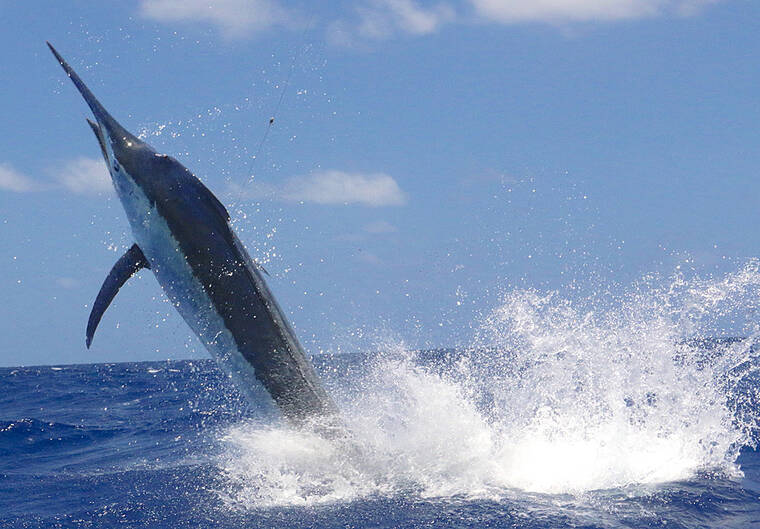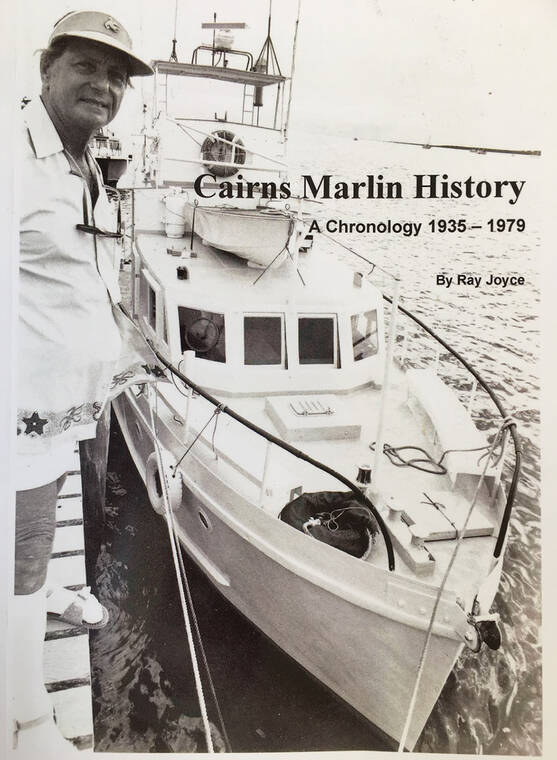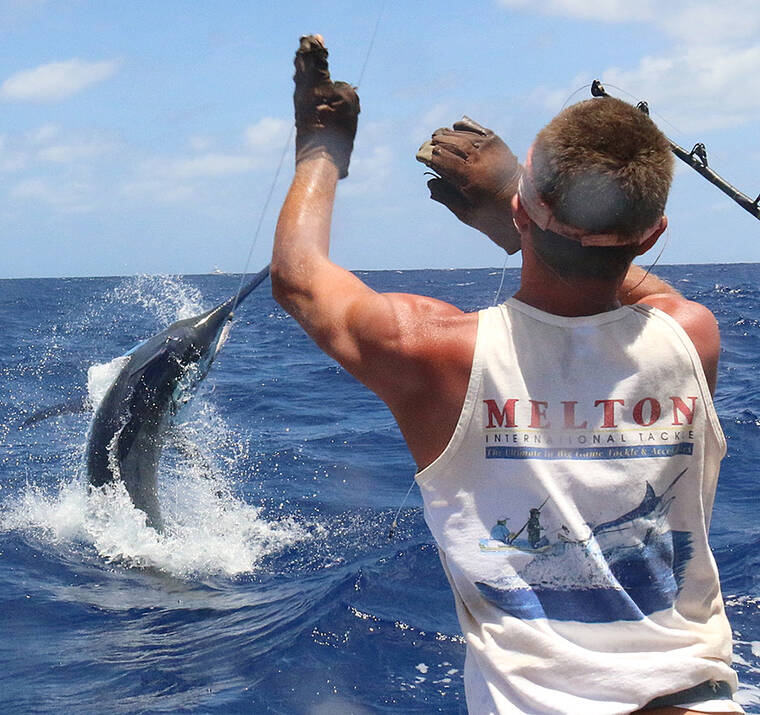The Bright Side: Fishing for dreams

No Kona fishermen won in Cabo tourneys this year, but an Aussie pro won big with this lure called a “Hibby” for Kona skipper Kevin Hibbard, made in Kona by Marlin Magic Lures. (Kevin Hibbard/Special to West Hawaii Today)

A giant black marlin leaps out of the water. (Courtesy photo/Special to West Hawaii Today)

“Cairns Marlin History: A Chronology 1935-1979” by Roy Joyce. (Jody Bright/Special to West Hawaii Today)

Ty works to bring in a giant black marlin in this October 2013 photo. Back in the days profiled in “Cairns Marlin History: A Chronology 1935 - 1979,” and continuing through the 1990s, many Kona fishermen went down under to fish the Great Barrier Reef to take a crash course in catching giant black marlin. (Courtesy photo/Special to West Hawaii Today)
A friend returning from Australia recently was kind enough to haul back a couple of copies of a book titled: “Cairns Marlin History: A Chronology 1935 to 1979.”
A friend returning from Australia recently was kind enough to haul back a couple of copies of a book titled: “Cairns Marlin History: A Chronology 1935 to 1979.”
The book is an incredible work of painstaking detail, and it gives the reader a unique insight into the characters compelled to explore, understand and ultimately develop the Great Barrier Reef (GBR) frontier.
Like most good books, Ray Joyce’s book made me think about things I would not have pondered if I hadn’t read it. One of the things that occurred to me was the difference in what compelled people to fish back then, as compared with today.
Long about the start of October, many Kona fishermen fly away to distant ports of call as our season winds down and others gear up. Back in the days profiled in the book through the 1990s, many Kona fishermen went down under to fish the GBR to take a crash course in catching giant marlin. A few went to the Caribbean to try St. Thomas or the new fishery opening up in Venezuela. In those days, it was all about the fish, or finding new fishing grounds.
Nowadays, there is another place to go fish in October, but what compels fishermen to choose this fishing hole over any other is different. Those who like to fish for big money head to Cabo San Lucas for their marlin tournament season, and there are lots of these people. Only one Kona boy that I know of went down under for the giant black marlin season this year.
Interestingly, the fishing in Cabo can’t even compare to the fishing along the Great Barrier Reef. More marlin over 1,000 pounds have been caught on the GBR than anywhere else on earth. Cabo can boast exactly zero marlin caught 1,000 pounds or better, according to the Googler.
Cabo has giant purses in their tournaments because Cabo is very convenient to United States-based boat owners. More than one hundred American boats descend on Cabo each October, just to fish tournaments. The boat owners have a lot of money invested in their boats and entry fees. When they fish a tournament with a ten million dollar purse they want to field their best team, so they hire guys with the most experience. Kona pros have a skill set that makes them highly sought after by these boat owners. Pros, being pros, they go where they are paid to go.
When you combine a hefty wage with the chance to win a share of more than $10 million, you can see why some go up and right, instead of left and down, even when it is clear that the fishing is best left and down.
This can be explained, at least in part by this: Fishermen don’t really fish for fish. Fishermen fish for dreams.
Those dream can be as varied as are the fishermen who dream them up. To the working professional, that dream may be more money for their family. For a wealthy boat owner who already has money, they might dream of being able to say, “We Won! We won on MY BOAT!”
These dreams can come true in Cabo each October — sometimes. Not one marlin over the minimum weight of 300 pounds was caught for three straight years at the largest Cabo tournament. Finally, in 2022 qualifiers were weighed and after three years, there were winners. However, it took more than 600 boat fishing days to do it.
Still, they dream, and each year they return. Among the myriad, there is one common dream amongst all marlin fishermen, and that is the dream of catching a Grander.
Although there are far more granders in Australia than anywhere, there are no fences across the ocean to keep them from swimming away. Therefore, it is theoretically possible for granders to show up in Cabo, but if one ever did, I can’t find it. Though statistically improbable, guys fishing Cabo share the dream of catching a grander, along with everyone else.
Actually, there have probably been granders hooked in Cabo over the years, only to get away. But herein lies “the hook,” pun intended.
Nothing keeps anglers coming back more than an encounter with The One That Got Away. Many people who lost a big one get hooked and then go on to spend the rest of their life and a lot of their treasure, trying over and over again to catch the one that got away.
But the fact remains: that fish got away.
Seems to me it makes more sense to learn how to catch the next big one than eternally dream-ing of catching the one that got away. Fishing the GBR is the best way to learn how to catch the next big one in a short amount of time. You can learn this in Kona too, it just takes a longer amount of time.
An irony appears when looking at the difference in what compels people to fish now days as compared to years gone by. When it comes to the month of October, the lure of big money appears to have superseded the lure of big fish — even though a giant fish is the dream of every tournament angler.
But consider this, since all fishermen are dreamers, isn’t it reasonable that learning to be proficient at something most guys only dream about might just be as enriching as any other dream come true?
That’s why Kona pros get flown to Cabo. Some years one or two win, and their dreams come true. This year, none of the Kona pros won. Still they dream, and each year they return.


